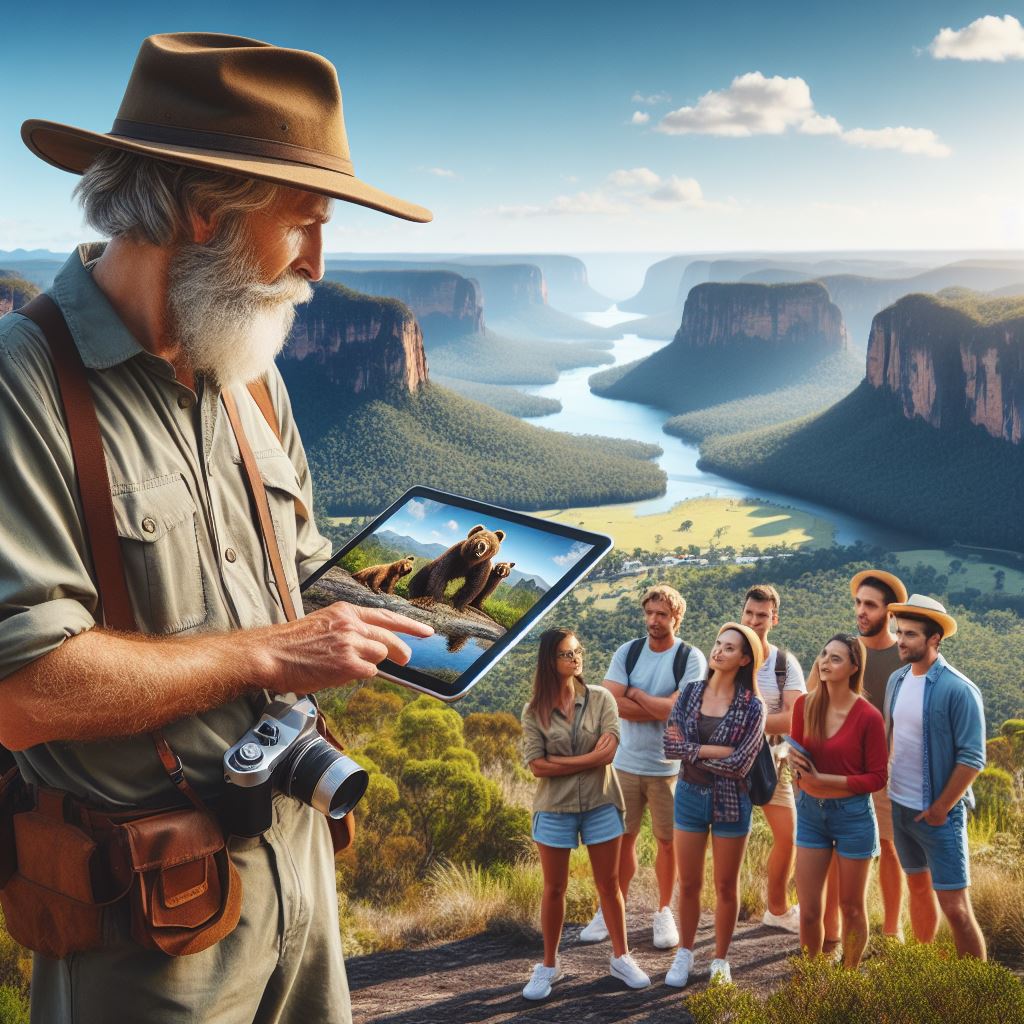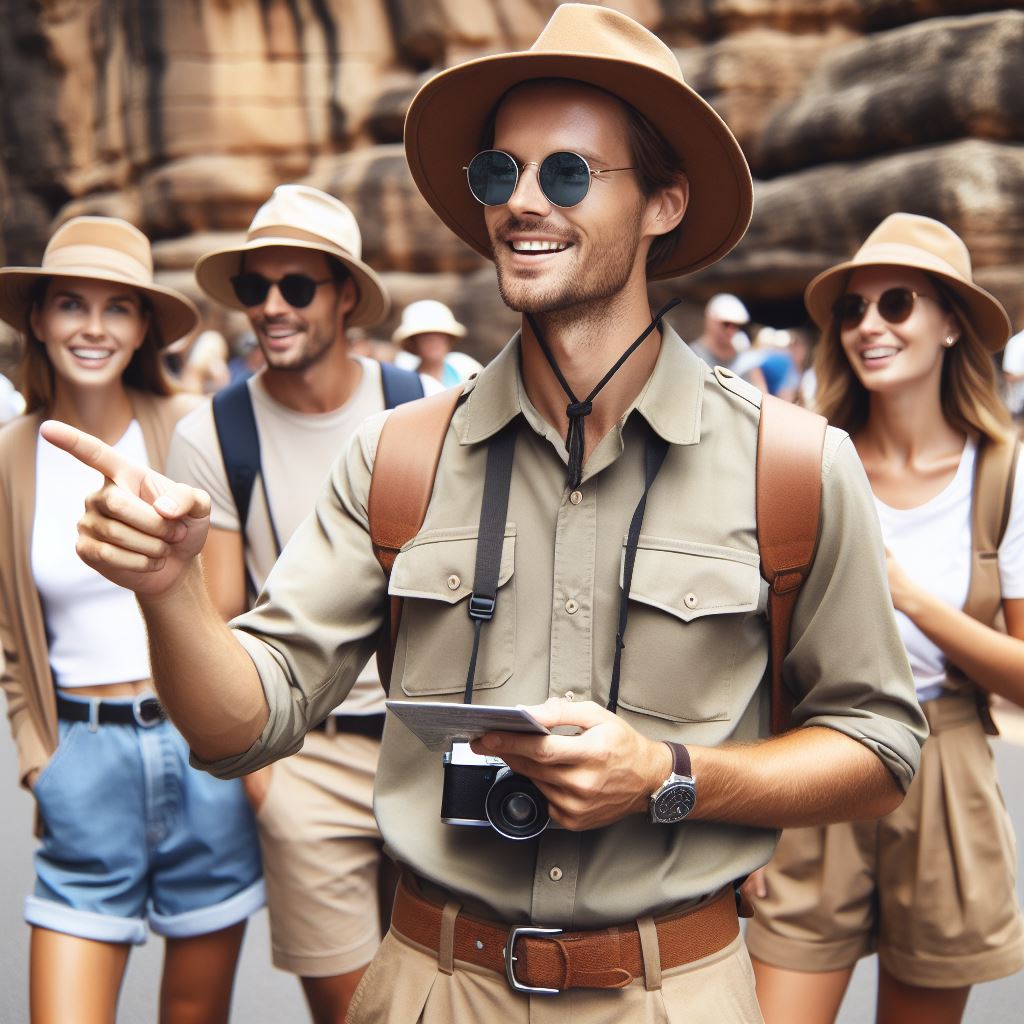Introduction
Technology has become an integral part of our lives, transforming numerous industries in the process.
It has significantly changed the way we communicate, work, and even travel.
In the world of tourism, the use of technology has brought about both advantages and disadvantages, particularly in the realm of tour guiding.
On one hand, technology has made information readily accessible and convenient for both tour guides and tourists.
Through the use of mobile applications and devices, important details about tourist destinations, historical facts, and local culture can be easily accessed and shared.
This enables tour guides to provide accurate and up-to-date information to their clients, enhancing the overall tour experience.
Moreover, technology has opened up opportunities for virtual tours, allowing individuals from different parts of the world to explore a destination without physically being there.
This can be especially beneficial for those with physical limitations or those who cannot afford to travel.
Virtual tours can provide a glimpse into different cultures and places, fostering a sense of global interconnectedness.
However, despite these advantages, technology in tour guiding also has its downsides.
The reliance on technology can lead to a lack of authentic human connections.
With tour guides focusing on digital devices instead of engaging with tourists directly, the personal touch and genuine interaction may be lost.
Additionally, the overreliance on technology may hinder the exploration of off-the-beaten-path destinations or local hidden gems, as popular tourist spots tend to dominate digital platforms.
In review, the use of technology in tour guiding offers immense benefits in terms of knowledge accessibility and virtual exploration.
However, it is crucial to strike a balance between technology and human interaction to retain the authenticity and personal connection that make tours truly memorable.
The next sections will delve deeper into the advantages and disadvantages mentioned above, providing a comprehensive evaluation of the impact of technology in tour guiding.
Read: Travel Agents: Trends in Australia for 2024
Advantages of Technology in Tour Guiding
Technology in tour guiding has undoubtedly brought numerous advantages for both tourists and tour operators. In this section, we will explore the different ways in which technology has positively impacted the tourism industry.
Improved accessibility for tourists
One of the key advantages of technology in tour guiding is the improved accessibility it offers to tourists.
With the advent of mobile apps and online platforms, tourists now have easy access to a wealth of information about tourist destinations, attractions, and activities.
These platforms provide comprehensive details, including maps, photos, reviews, and recommendations, enabling tourists to make well-informed decisions about their travel plans.
Furthermore, the availability of multilingual audio guides has significantly enhanced accessibility for tourists who face language barriers in foreign countries.
These audio guides provide translations of important information, allowing tourists to easily understand and appreciate the destinations they visit.
This feature has made travel more accessible and enjoyable for a broader range of individuals, regardless of their language proficiency.
Enhanced engagement through interactive experiences
Technology has revolutionized the way tourists engage with their surroundings during guided tours.
Virtual and augmented reality (VR/AR) applications have introduced a new level of immersion, enabling tourists to explore destinations in a more interactive and engaging manner.
For example, VR/AR can recreate historical events, allowing tourists to experience significant moments firsthand.
In addition, the gamification of tours through technology has added an element of excitement and entertainment. Interactive games, quizzes, and challenges incorporated into tours make the experience more engaging and memorable for tourists.
Gamification also encourages active participation and promotes learning, as tourists actively seek information to progress in the game.
Better organization and time management
The use of technology in tour guiding has significantly improved organizational aspects for both tourists and tour operators.
GPS and navigation tools have made it easier for tourists to navigate unfamiliar locations, ensuring they reach their desired destinations efficiently.
These tools provide real-time directions, eliminating the need for paper maps and the stress of getting lost.
Additionally, technology enables the provision of real-time updates and scheduling assistance. Tourists receive notifications about any changes or updates regarding their itinerary, ensuring they stay informed throughout the tour.
This feature enhances time management, allowing tourists to make the most of their limited time in a destination. With the assistance of technology, tours can be efficiently organized, ensuring a smooth and seamless experience for all participants.
In general, technology has brought a multitude of advantages to tour guiding.
Improved accessibility, enhanced engagement through interactive experiences, and better organization and time management have all contributed to enhancing the overall tourist experience.
As technology continues to advance, it is likely that tour guiding will further evolve, offering even more innovative and immersive experiences for tourists around the world.
Read: How to Become a Travel Agent in Australia
Disadvantages of Technology in Tour Guiding
Technology has brought numerous advancements in various industries, including tour guiding. However, like any other innovation, it has its fair share of disadvantages. In this section, we will explore the downsides of technology in tour guiding.
Loss of personal touch and human interaction
One of the primary disadvantages of relying heavily on technology in tour guiding is the potential loss of personal touch and human interaction. With automated systems and gadgets, the personal connection between the guide and tourists can weaken.
Lack of personalized recommendations
Tourists may miss out on customized recommendations that only a knowledgeable human guide can provide. Technology-driven platforms often rely on algorithms, which may not factor in individual preferences and needs.
Limited opportunities for spontaneous interactions
Genuine connections and spontaneous interactions can enhance the tour experience. However, when technology takes center stage, tourists may have fewer chances to engage with locals or other travelers spontaneously.
Your Personalized Career Strategy
Unlock your potential with tailored career consulting. Get clear, actionable steps designed for your success. Start now!
Get StartedDependence on technology and potential technical issues
While technology can be helpful, tour guides should be cautious about becoming too reliant on it. Technical issues can arise, leading to problems or disruptions during tours.
Reliability of Wi-Fi or network connections
A tour that heavily relies on internet connectivity may face difficulties in areas with weak Wi-Fi signals or inadequate network coverage. This can hinder the guide’s ability to access real-time information or provide interactive experiences.
Risks of technology failure during tours
Technology can fail at critical moments, leaving tour guides ill-equipped to handle unexpected circumstances. Equipment malfunctions, software glitches, or power outages might disrupt the tour flow and diminish the overall experience.
Privacy and security concerns
In an increasingly connected world, privacy and security have become vital concerns. The integration of technology in tour guiding comes with potential risks to sensitive information and personal safety.
Collection and misuse of personal data
When using technology-driven platforms, tourists often share personal information. There is a possibility of unauthorized collection, storage, or misuse of this data, putting their privacy at risk.
Potential for cyberattacks and hacking
Cybersecurity threats continue to grow, and the tour guiding industry is not exempt.
Hackers may target tour guide systems or online platforms, jeopardizing both the guide’s and the tourists’ safety by accessing confidential information or disrupting operations.
In essence, while technology offers numerous benefits in tour guiding, it is essential to acknowledge and address its drawbacks.
The loss of personal touch, dependence on technology, and privacy and security concerns are significant issues to consider.
Striking a balance between technology and human interaction is crucial to ensure a positive and safe tour experience for all parties involved.
Read: Travel Agents: The Future in Aussie Tourism

See Related Content: Innovations in Australian Hotel Management
Finding the Balance: Incorporating Technology Responsibly
In today’s tech-driven world, the travel industry has embraced technology to enhance the tour guiding experience. However, finding the right balance between utilizing technology and maintaining human interaction is crucial.
Importance of maintaining human interaction
- Role of the tour guide as a knowledgeable and personable resource
- Encouraging conversation and questions from tourists
It is of utmost importance to understand the significance of maintaining human interaction in tour guiding. While technology can provide information, a tour guide plays a vital role as a knowledgeable and personable resource.
No app or gadget can replace the genuine human connection that a knowledgeable guide can offer.
The tour guide’s ability to engage with tourists, encourage conversation, and answer questions adds depth and authenticity to the experience.
By creating a comfortable and interactive environment, tourists can actively participate and feel more connected to the destination and its culture.
Safeguarding privacy and security
- Ensuring compliance with data protection laws
- Implementing secure technology systems
While incorporating technology, safeguarding privacy and security should not be overlooked. Tour operators must ensure compliance with data protection laws, especially when collecting personal information from tourists.
By implementing secure technology systems and protocols, tour guides can protect the privacy of their guests and maintain a trustworthy relationship.
Utilizing technology as a complementary tool
- Enhancing the overall experience rather than replacing human guides
- Balancing the use of technology with authentic cultural experiences
Technology should be utilized as a complementary tool rather than a complete replacement for human guides.
While digital platforms can enhance the overall experience, they should not overshadow the importance of authentic interactions.
Balancing the use of technology with genuine cultural experiences ensures that tourists get a holistic and enriching tour.
Technology can provide unique perspectives, virtual reality experiences, and augmented reality enhancements.
It can showcase historical images, videos, or audio guides, enriching the tourist’s understanding of the destination.
However, it is crucial to strike a balance and not let technology overshadow the essence of the tour – genuine human connections, cultural exchanges, and immersive experiences.
Moreover, tour operators must carefully select and implement technology solutions that align with the needs of the destination and the expectations of their guests.
Embracing technology should enhance the tour experience, making it more engaging, informative, and memorable.
It should not be used merely as a marketing gimmick or as a means to replace human guides.
By finding the right balance, tour operators can leverage technology to augment their offering while preserving the authentic charm of their destinations.
Incorporating interactive technologies, such as live translations or digital storytelling, can bridge language barriers and create a more inclusive experience.
In fact, incorporating technology responsibly in tour guiding requires finding the perfect equilibrium between utilizing its benefits and maintaining human interaction.
Tour guides play a significant role in providing knowledge, personal connections, and fostering engaging conversations.
Safeguarding privacy and security and utilizing technology as a complementary tool are vital considerations.
By striking the right balance, tour operators can enhance the overall experience and create unforgettable journeys for their guests.
Stand Out with a Resume That Gets Results
Your career is worth more than a generic template. Let us craft a resume and cover letter that showcase your unique strengths and help you secure that dream job.
Get HiredRead: Salary Guide: Travel Agents in Australia
You Might Also Like: Balancing Budgets: Event Planning Essentials
Conclusion
In this exploration of technology in tour guiding, a spectrum of advantages and disadvantages emerges, underscoring the transformative impact of technological integration.
On the positive front, technology facilitates immersive experiences, enriches storytelling, and broadens accessibility for tourists.
Simultaneously, concerns arise regarding over-reliance, potential disconnection from authentic experiences, and challenges associated with technological malfunctions.
Advantages include heightened engagement through augmented reality and seamless information dissemination.
However, the drawbacks encompass a risk of overshadowing the human touch in guiding and the potential distraction technology poses to the natural surroundings.
Striking a balance between leveraging technology for enhancement without compromising the authenticity of the touring experience is paramount.
It is imperative to underscore the need for a judicious and responsible approach in integrating technology into tour guiding.
Harnessing its potential to complement, rather than replace, the guide’s role ensures a harmonious coexistence of tradition and innovation.
Responsible utilization addresses the concerns associated with technological intrusion, preserving the essence of human-guided interactions while leveraging tech advancements for added value.
As we gaze into the future of technology in the tour guiding industry, a dynamic landscape unfolds.
The synergy between human expertise and technological innovation presents a promising trajectory.
Anticipating a future where responsible integration fosters a harmonious blend, we envision a tour guiding industry that capitalizes on technology’s strengths while cherishing the enduring value of human connection.
The future beckons us to navigate this equilibrium, embracing technology as an enabler rather than a replacement, ensuring that the essence of guided tours evolves without losing the authentic touch that defines a truly enriching experience.




